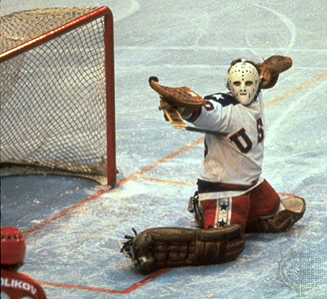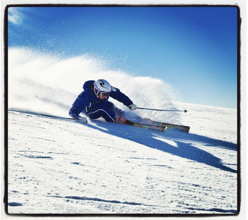ACL Injuries and Downhill Skiing: How to Prevent Them and Still be a Bad Ass
Today’s guest post comes from Roland Searle, a limey Brit who now resides in Canada and is a high level ski coach. Roland also works in my gym, so he gets to see me sing poorly and get clients doing all sorts of weird and funky stuff, and he’s slowly figuring out that he needs to work more on hip extension strength than muscle ups.
With winter just around the corner, my thoughts and thoughts of many fitness and recreation enthusiasts turn to that of snow-sports I.e Sliding down the hill on pieces of wood and metal, sometimes in control, but more often without much at all
Having made the move to Canada 6 years ago from the UK, chasing winter seasons, as a professional ski instructor, skiing the best that Canada has to offer in British Columbia and Alberta I want to touch on the one specific fitness related issue that I have come across most during my career. The ACL!
During the life of a recreational skier of ACL tears are common. They cause prolonged absence from on-hill activities, can have a detrimental effect on our working lives off hill and all together suck more than the Toronto Maple Leafs. (Getting my knowledge of Canadian sports in early eh)
So what’s an ACL?
The ACL (anterior cruciate ligament) is located in the knee and is part of the mechanism that helps stop the joint from giving way under pressure, it works by preventing the tibia (shin bone) from sliding too far forward, as well as commanding and regulating knee rotation.
What does an ACL tear feel like?
Bloody painful. That is all.
Thats not good…What can I do to stay injury free?
In my opinion ACL protection should be part of every snowboarder and skier’s pre season training program. It’s not possible to strengthen the ACL itself, as ligaments do not grow stronger or larger, however it is possible to make improvements in the overall stability of the muscle groups around the core, and the knee joint itself.
So:
- Introduce correct knee alignment. If you have excessive Knee Valgus when you squat you may have some issues. ( Valgus – This is when there is an overly large amount of internal hip rotation and hip adduction)
Knee Valgus can contribute to ACL injury due to the inward-rotated position. This places high amounts of unwanted and possibly injury creating stress on the ACL – here’s a photo of that guy from that movie Friday the 13th showing Knee Valgus:
You can find out more about knee valgus and some ways to improve and what may in fact be causing it from Bret Contreras informative blog here:
- Skiers & snowboarders will often have much larger quadriceps compared to their hamstrings. (Ask Dean about my excellent proportionality.)
When the Quadricep is contracting, the hamstrings are relaxing, allowing movement, however if they are weak and /or tight they may not protect the ACL from injury during a particularly strong quadriceps contraction.
[Note from Dean: This isn’t entirely accurate, as anyone who has squatted could tell you their hamstrings are working hard too, but it’s not entirely false either. During the squat, the quads lengthen at the knee and shorten at the hip, while the hamstrings lengthen at the hip and shorten at the knee, producing a net length change close to zero in each. This is known as Lombards Paradox. The concept of reciprocal inhibition which Roland mentioned, while convenient, isn’t the best answer. Check out the Bret Contreras article mentioned earlier]
Snow sports enthusiasts should try to work on dynamic balance with stability and strength training to effectively prepare the knees for an injury-free winter season. Looking at training both front and back of the leg in proportion. So what do we do? Break out the bosu? Do squats on a Swiss Ball? Try some of these?:

All are highly entertaining, but I’m unsure of the practicality. Instead I would suggest Bamboo Squats, shown here by the host of this site Mr Somerset himself:
[youtuber youtube=’http://www.youtube.com/watch?v=e4X1G7jtseY&feature=c4overview&list=UUVEVIEb8t9r-GmkeANOyvAg’]
Why do movements on unstable ground where injury could be greater, instead use unstable weight? This can be adapted into deadlifts:
[youtuber youtube=’http://www.youtube.com/watch?v=F6xPIZC6lhM’]
This will hammer the hamstrings and glutes and let’s be honest not everyone has a horse lying around.
- Get hardCORE- Snowpsorts are dynamic and active sports, they require the body to move around all three planes of motion. Core training routines – that work both the internal and external core muscles can help us protect against ACL injury. Coming off Dean’s post rehab course, last month I found a new love for deadbugs and a realisation that not everything core needs to be done with a stability ball, no matter how cool it looks!
Why not try instead, some of these deadbug variations, trust me, risk of injury is much lower, and probability of improvement is much higher. Even if you might not look as cool.
[youtuber youtube=’http://www.youtube.com/watch?v=iVMxmK1diFE’]
I hope some of this insight can help you all make it through this winter season injury free and a little more aware of what you can do to keep yourself that way. If you have any questions you can reach me via email which is located below. Have a wonderful winter wherever you are and stay healthy!
About the Author:
Roland Searle is a proudly British Personal Trainer at World Health City Centre in Edmonton and is a 25 year old full time examiner and trainer for the Canadian Ski Instructors Alliance(CSIA), and is partial to Earl Grey Tea.
He holds the highest certification attainable in Canada and has coached National Team Athletes, helped Television personalities with their snowplough turns and has an all round love for everything winter. You can ski with him privately this winter in Banff, at any of the three world class resorts head to www.skibig3.com to find more information about his winter home and how to book.



4 Responses to ACL Injuries and Downhill Skiing: How to Prevent Them and Still be a Bad Ass